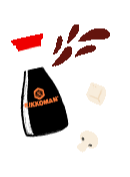A guide to types of mushrooms & recipes to cook with them
30. August 2023

Mushrooms are in high season in late summer and autumn. However, there are many varieties all year round.
Mushrooms are a very healthy food because they are up to 90 percent water and contain just 20 kilocalories per 100 grams, which makes them very low in calories. Mushrooms also contain important B vitamins and vitamin D. Despite all these healthy attributes, always take care when picking mushrooms in the wild because 150 of the varieties that grow in Europe are poisonous. Your safest bet is the farmer’s market or supermarket, because they definitely don’t sell any poisonous mushrooms. Cooking mushrooms is very simple: just fry or grill the fresh mushrooms and add some herbs. Mushroom dishes taste even better if you add your favourite Kikkoman sauce.
Do mushrooms have health benefits?
Fresh mushrooms are really low in calories – just 20 per 100 g and contain B vitamins and vitamin D, which makes them a healthy food source. However great care must be taken when foraging for wild mushrooms because some are poisonous. Unless you are an expert, it is safest to buy wild mushrooms from supermarkets or farmer’s markets to ensure they are the edible varieties. Mushrooms are very versatile and lend themselves to grilling, baking, frying, or try button ones raw in salads. Of course, mushroom dishes taste even better if you add your favourite Kikkoman sauce.

What are the different varieties of mushrooms?
- Button, chestnut and field mushrooms are the most well-known varieties of mushroom in the UK. They typically have firm white flesh and a round “cap” and contain a generous amount of vitamin B and protein. Buttons are great in a creamy sauce and in pasta dishes or fry them and serve as part of a full English breakfast. They are also delicious when threaded onto a skewer to make a delicious barbecue snack. Larger field and portabello mushrooms are suitable for stuffing and baking – try garlic, herbs and breadcrumbs.
- Chanterelle and porcini are wild mushrooms. They cannot be easily cultivated and only grow in woodland during the Autumn if the soil is damp and there is plenty of sunshine. This makes them a bit more expensive. Chanterelles have a mild, savoury taste and are popular with mushroom connoisseurs. Porcini mushrooms, also called ceps, have a slightly nutty flavour and are quite “meaty” in texture so suit risottos and beef wellington.
- Shiitake mushrooms are the number one Oriental fungi. They have been used for centuries as both food and a remedy. Today these tasty mushrooms are widely available dried in the UK. The drying process brings out their natural umami, that special full-bodied flavour that makes Kikkoman Naturally Brewed Soy Sauce so special. To experience maximum umami flavour in a dish, combine rehydrated shiitake with Kikkoman soy sauce and add to your recipe.

How do you prepare mushrooms?
Our tips for preparing mushrooms are:
- Do not wash mushrooms – simply brush away any dirt using a pastry brush. You do not have to peel mushrooms either unless they have turned slightly brown or beginning to go slimy
- Fresh mushrooms have a pleasant woodland aroma. Don’t ever use mushrooms that smell mouldy.
- If possible, use the mushrooms the day you buy them. If you’ve bought them to cook for the next day, place them in a paper bag as mushrooms cannot “breathe” in plastic packaging.















![[Translate to Englisch (UK):] [Translate to Englisch (UK):]](https://www.kikkoman.co.uk/fileadmin/_processed_/c/d/csm_1039-recipe-page-Easy-Carrot-soup_mobile_7366116d92.webp)
![[Translate to Englisch (UK):] [Translate to Englisch (UK):]](https://www.kikkoman.co.uk/fileadmin/_processed_/1/0/csm_1089-recipe-page-Roasted-Turkey_mobile_624c3fe100.webp)
![[Translate to Englisch (UK):] [Translate to Englisch (UK):]](https://www.kikkoman.co.uk/fileadmin/_processed_/c/5/csm_MainDishes_recipe-collection_desktop_2x_ef5962097e.webp)
![[Translate to Englisch (UK):] [Translate to Englisch (UK):]](https://www.kikkoman.co.uk/fileadmin/_processed_/b/e/csm_1101-recipe-page-Authentic-Japanese-soy-sauce-ramen_mobile_6bf05afcae.webp)
![[Translate to Englisch (UK):] [Translate to Englisch (UK):]](https://www.kikkoman.co.uk/fileadmin/_processed_/e/b/csm_918-recipe-page-pumpkin-hummus_mobile_d372eb934b.webp)

![[Translate to Englisch (UK):] [Translate to Englisch (UK):]](https://www.kikkoman.co.uk/fileadmin/_processed_/0/d/csm_928-recipe-page-prawn-and-vegetable-stir-fry-noodles_mobile_78dc5b25bc.webp)




